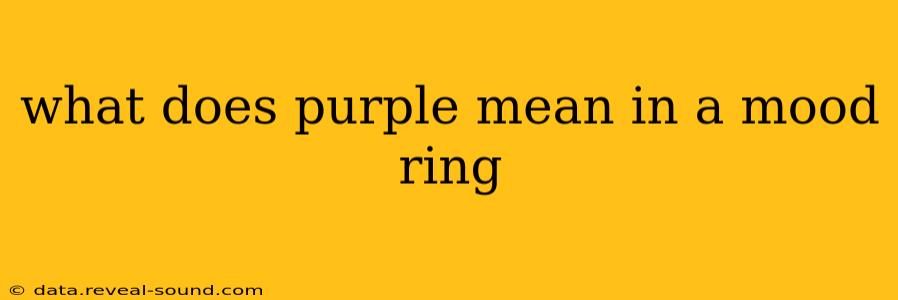What Does Purple Mean in a Mood Ring? Decoding the Colors of Your Mood Ring
Mood rings, those fascinating pieces of jewelry that supposedly change color based on your body temperature, have captivated people for decades. While their ability to accurately reflect your emotional state is debated, the changing colors are undeniably captivating. One of the most intriguing colors is purple, but what does purple mean in a mood ring? Let's delve into the meaning behind this regal hue and explore other frequently asked questions surrounding these intriguing accessories.
What does purple signify in a mood ring?
According to the traditional interpretations associated with mood rings, purple often signifies a balanced and tranquil state of being. It suggests a sense of calm, peacefulness, and emotional equilibrium. Think of the serene, violet hues of a twilight sky – this is the feeling often associated with purple on a mood ring. However, it's crucial to remember that these interpretations are largely based on subjective associations and not scientific evidence.
What are the different colors in mood rings and their meanings?
Mood rings typically display a range of colors, each with its own associated meaning (again, based on traditional interpretation). These colors and their meanings are generally considered as follows:
- Black: Stress, tension, or negative emotions
- Dark Blue/Indigo: Sadness, anxiety, or feelings of being overwhelmed
- Blue: Calmness, contentment, or a relaxed mood
- Green: A balanced and healthy state of being.
- Yellow/Gold: Excitement, happiness, or a feeling of optimism
- Orange: Energetic, enthusiastic, or perhaps slightly irritable
- Red: Passionate, angry, or feeling intense emotions
- Purple: Calm, tranquil, balanced, peaceful
It's important to note that the color changes are subtle, and the interpretation of the color can be subjective.
How accurate are mood rings in reflecting emotions?
The science behind mood rings is straightforward: they respond to changes in your skin temperature. While changes in skin temperature can be correlated with emotional states (for example, stress can cause sweating and thus a change in temperature), the connection isn't direct or reliable. Many factors, including ambient temperature, exposure to sunlight, and even the pressure applied by wearing the ring, can influence the color displayed. Therefore, while mood rings are fun and fashionable, they shouldn't be taken as an accurate or precise indicator of your emotional state.
Why does my mood ring change colors even when I feel the same?
As mentioned, several factors aside from your emotional state can affect the color of your mood ring. Changes in ambient temperature, your own body temperature fluctuations throughout the day, and even the pressure of wearing the ring itself can cause the liquid crystal within to shift colors.
Are there different types of mood rings?
While the basic principle remains the same, there are different styles and designs of mood rings available. Some are made with more sophisticated liquid crystals or thermal sensitive materials, potentially offering a wider range of colors or subtle color variations. However, the underlying mechanism remains unchanged; they still respond to skin temperature.
In conclusion, while the meaning ascribed to purple in a mood ring – calmness and tranquility – is a popular interpretation, it's essential to understand the limitations of mood rings in accurately reflecting emotions. They serve more as a fun fashion accessory than a reliable emotional barometer. The color changes are based on temperature fluctuations, influenced by a multitude of factors beyond solely emotional states.
